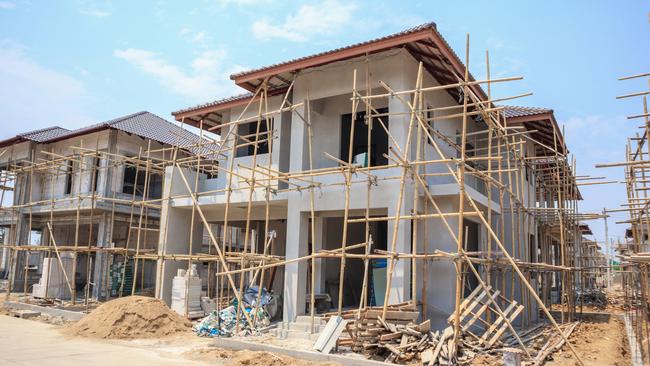
Some home building companies have the funds to cover the losses.
Metricon’s owners have injected $30m and other investors are being sought, prompting the Commonwealth Bank to double its Metricon lending facility. The NSW and Victorian governments have been asked to help. But the crisis goes well beyond Metricon and the banks and insurers still have huge decisions to make.
The losses are substantial because the industry signed a multitude of fixed priced contracts that are proving far more expensive to complete than the contracted fixed price amid rising materials costs and supply delays.
The survival of many of these builders depends on insurance companies, led by QBE, continuing to guarantee to suppliers that the builders will pay. If the insurance companies pull the rug and refuse to insure the debts of major builders, we will see a string of collapses and widespread consumer mortgagee misery.
As shown in Metricon, the willingness of the insurers to back the building companies is closely linked to the willingness of banks to continue to loan money to cover the loss-making operations where required.
My discussions with building groups makes me wonder if bank directors, let alone their shareholders, fully realise the role that some banks played in creating this crisis and the danger past actions pose to certain banks.
Suppliers to the builders are fully aware of the losses and dangers but continue to supply, provided amounts owing are guaranteed via the insurance policies. If the insurers stop providing the guarantees for any major builder, then suppliers will simply not be able to afford to take the risk and will severely curtail or stop supplies. And, of course, that is the end of the road for that builder and their customers.
As in Metricon, banks often ask for extra equity from the builders and no doubt some have provided that equity.
Other families are reluctant because they don’t want to jeopardise remaining family assets and they point out that the banks are partly responsible for the current mess because of past bank lending policies that were imposed on builder/developers.
Some banks had a policy that more financing was available to builders where the builder entered into fixed priced contracts with homebuyers.
To the builders this made no sense until they realised that this unusual lending stance by the banks was devised so the bank’s home loan operations could boom because it was much easier to lend on mortgage when the exact home cost was known. Accordingly, banks declared monumental “profits” as they showered money on home borrowers based on the fixed price purchase contracts they had encouraged.
Of course, neither the builders nor the banks realised the raw material price rises that were on the horizon.
I emphasise that this information comes from building groups who are adamant that this was the policy of some banks. If the building groups claims are backed by evidence – and we have major building collapses – then almost certainly we will see massive class actions against some banks because, on the surface, they jeopardised the solvency of builders to boost their home loan profits.
To protect shareholders, before a bank makes any decision to pull the rug on a major builder, I urge their non-executive directors to personally check the paperwork to see what undertakings and loan arrangements were made by their bank to major builders.
When a big commercial builder collapses, like Probuild, it is possible to get another builder to take on the construction. But if we see a collapse of large home builders then thousands of individual housing contracts will be uncompleted. We would also be looking at large numbers of small contractors going to the wall. There will be many people who have not only spent their savings on deposits but will have started borrowing from the bank to fund their house.
Completing these houses would be a monumental task taking many years. Banks will lose large amounts of money and naturally any that encouraged fixed priced contracts will be vulnerable to court action. Accordingly, QBE and the other insurers, plus the banks, must now be wondering whether other major home builders are like Metricon and are too big to fail.
The Metricon rescue was helped because extra equity was put on the table but it may also be a sign that the banks will not take tough action because of the consequences. There are no certainties because banks traditionally do not hesitate. Of course, fixed price contracts have now been modified by most builders so their enterprises now have sound businesses that can recover. But funding losses is not normally good banking.
One can only hope that in this dangerous time none of the builders have used the deposit money received on home building contracts to keep going and reduce their need for extra bank finance to cover the losses.







Almost every major home builder in Australia is losing money, creating the danger of more “too big to fail” situations like Metricon.